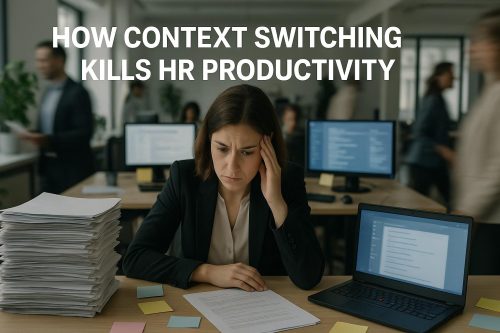Leave of absence requests are complex and costly for companies. Many organizations underestimate the financial and operational burdens of leave management, including unpaid leave, voluntary leave, personal leave, FMLA leave, and even leave for jury duty.
Did you know paid time off can cost 20.9% to 22.1% of payroll? This includes direct and indirect costs, compliance risks, productivity impacts, and Human Resources administrative burdens.
This article explores the hidden costs of leave of absence requests. We’ll examine processing time, expenses, request frequency, compliance pitfalls, and how leave policies vary. Understanding these factors is crucial for effective absence management, whether you lead HR at a small business or a global corporation.
The Direct Costs of Leave of Absence
Let’s analyze the direct financial costs of employee leave. According to the Society for Human Resource Management (SHRM), paid time off costs about 15.4% of payroll.
These direct costs include wages paid during leave (8.1% of payroll), overtime to cover absences (5.7%), and costs for replacement workers (1.6%).
For a company with a $10 million annual payroll, that’s over $1.5 million yearly in direct leave-related expenses. But there are also indirect costs to consider.
Indirect Costs of Leave of Absence

Productivity losses from absences can be substantial, although difficult to quantify. SHRM found indirect costs due to productivity loss average 6.2% of payroll.
Factors include lower productivity of replacement workers (22.6% to 36.6% loss), co-worker productivity loss (29.5% average decrease), and supervisor productivity loss (15.7%).
Combined direct and indirect costs of paid time off range from 20.9% to 22.1% of payroll. For our $10 million payroll company, that’s over $2 million annually.
Administrative Time and Effort
Processing and tracking leave requests requires time and effort. According to SHRM, supervisors spend 4.2 hours weekly dealing with absences.
That equals 5.3 weeks yearly per supervisor. Tasks like finding replacements, adjusting workflows, and providing training consume time.
Frequency of Leave Requests
How often do companies handle leave requests? It varies, but the numbers are significant. The average paid time off rate is 8.1% of workdays, while sick leave averages 3.5%.
In a 250-day work year, employees take about 20 paid leave days, with almost 9 sick days.
Compliance Risks of Mismanaging Leave
Mismanaging leave can expose companies to legal risks. Laws like FMLA and ADA create complex employer obligations. Poor leave tracking and management can lead to Department of Labor investigations, employee lawsuits, settlements, and reputational damage. The average 2019 FMLA lawsuit settlement exceeded $350,000.
Variations in Leave Policies
Leave policies differ based on location and industry. Several states, such as California, New York, and Washington, mandate paid sick, family, and medical leave.
State-by-State Variations
- California requires paid sick leave.
- New York has a paid family leave program.
- Washington state mandates paid medical and family leave.
Multi-state companies must comply with varying state requirements regarding paid leave and employee leave policies.
Industry-Specific Considerations
Different industries face unique leave management challenges including Healthcare, Manufacturing, and Retail. Healthcare needs enough staff for patient care. Manufacturing can experience production disruptions. Retail leave needs fluctuate seasonally.
Company Size Factors
Smaller companies, with limited resources, may find leave management challenging. Larger enterprises face policy coordination challenges across multiple sites and departments.
Global Leave Management Challenges
Multinational companies encounter complex leave management due to varying leave requirements and cultural norms.
For example, the EU mandates 4 weeks of paid vacation yearly. Japan has a culture of limited vacation use despite generous policies. Australia offers long service leave after extended employment.
Global organizations require sophisticated systems for tracking leave across borders while maintaining local legal compliance and leave entitlements. Paid leave is typically available for various life events.
Strategies for Effective Leave Management
Effective leave management requires planning and established processes for employee requests and voluntary leave.
Implement Robust Tracking Systems
Accurate tracking is essential, yet SHRM research shows only 24% of organizations track leave liabilities accurately.
A comprehensive system can automate leave requests, track time, generate reports, and manage compliance documentation. Consider implementing new leave tracking to help employees utilize available options such as sick days, duty leave, foster child care leave, and military family leave.
Develop Clear Policies and Procedures
Clear policies help set expectations. Include available leave types, request processes, documentation needs, and return-to-work procedures. Consider how these apply to military caregiver leave and provide specific examples within the procedures. Communicate these policy guidelines to avoid confusion about available leave entitlements, such as foster child care leave and military family leave. These policies should clarify guidelines around compensation during employee leave time, addressing questions like ‘do you get paid on unpaid leave’. Providing employees with these details upfront is essential.
Train Managers and Supervisors
Managers play a vital leave management role. Provide training on company policies, legal requirements (FMLA, ADA), documentation, and handling leave situations. It is vital to understand and explain the difference between Leave of Absence (LOA) and specific leaves like Family Medical Leave (FML) protected by FMLA.
FAQs about leave of absence
What qualifies as a leave of absence?
A leave of absence is an extended time away from work, longer than vacation or sick time. It can be paid or unpaid, depending on policy and reason, such as medical issues, family care, education, or personal matters.
What’s the difference between LOA and FMLA?
LOA is a general term for extended time off. FMLA is a specific legally protected leave. Eligible employees get up to 12 weeks of unpaid, job-protected leave for specific family and medical reasons, encompassing family leave, medical leave, and sick leave.
Does leave of absence mean quitting?
No. A leave of absence is a temporary break, intending to return. Terms are agreed upon with your employer.
How is a leave of absence requested?
Review company policies, determine needed leave type and duration, and schedule a meeting with your supervisor or HR. Explain your request, provide documentation, and confirm arrangements in writing. When submitting your request for a leave, be sure to clarify if you intend to take sick leave, paid time off, or any other available options to facilitate appropriate categorization by your employer.
Paid leave should be planned and approved according to your employer’s policies. For example, if you’re considering time off to care for a sick family member or a new foster child, clearly specify your reason when applying for a leave. Additionally, familiarize yourself with the provisions and benefits outlined in the Family Medical Leave Act and discuss the same with your employer, particularly in situations involving extended absences.
you are informed about the continuation of benefits like health coverage during your leave to plan effectively. Consider payroll services if needed for pay employees smoothly during leaves. For leaves due to medical reasons, understanding available resources for compensation like workers compensation can help you navigate the period. Make use of existing employee time management systems or employee leave management tools to plan your absence efficiently and collaborate effectively with HR.
Conclusion
Effective leave management is vital for cost control, productivity, and compliance. The true cost extends beyond paid time to productivity loss, administration, and legal risks.
Robust systems, clear policies, manager training, and considering outsourcing improve leave management. This controls costs and supports employee well-being.
As the workplace evolves, effective leave management is critical. Understanding leave’s impact and implementing strategic practices can improve efficiency and employee support. This understanding also clarifies legal obligations related to employee leave and equips HR to respond effectively.
 Productivity losses from absences can be substantial, although difficult to quantify. SHRM found indirect costs due to productivity loss average 6.2% of payroll.
Factors include lower productivity of replacement workers (22.6% to 36.6% loss), co-worker productivity loss (29.5% average decrease), and supervisor productivity loss (15.7%).
Combined direct and indirect costs of paid time off range from 20.9% to 22.1% of payroll. For our $10 million payroll company, that’s over $2 million annually.
Productivity losses from absences can be substantial, although difficult to quantify. SHRM found indirect costs due to productivity loss average 6.2% of payroll.
Factors include lower productivity of replacement workers (22.6% to 36.6% loss), co-worker productivity loss (29.5% average decrease), and supervisor productivity loss (15.7%).
Combined direct and indirect costs of paid time off range from 20.9% to 22.1% of payroll. For our $10 million payroll company, that’s over $2 million annually.
 Productivity losses from absences can be substantial, although difficult to quantify. SHRM found indirect costs due to productivity loss average 6.2% of payroll.
Factors include lower productivity of replacement workers (22.6% to 36.6% loss), co-worker productivity loss (29.5% average decrease), and supervisor productivity loss (15.7%).
Combined direct and indirect costs of paid time off range from 20.9% to 22.1% of payroll. For our $10 million payroll company, that’s over $2 million annually.
Productivity losses from absences can be substantial, although difficult to quantify. SHRM found indirect costs due to productivity loss average 6.2% of payroll.
Factors include lower productivity of replacement workers (22.6% to 36.6% loss), co-worker productivity loss (29.5% average decrease), and supervisor productivity loss (15.7%).
Combined direct and indirect costs of paid time off range from 20.9% to 22.1% of payroll. For our $10 million payroll company, that’s over $2 million annually.





